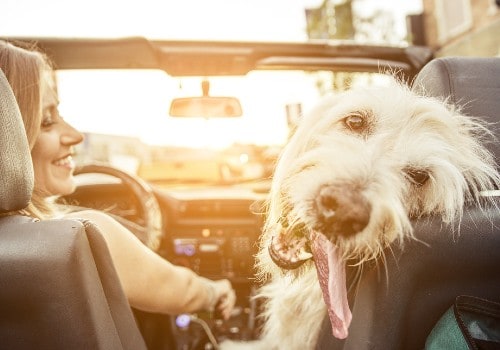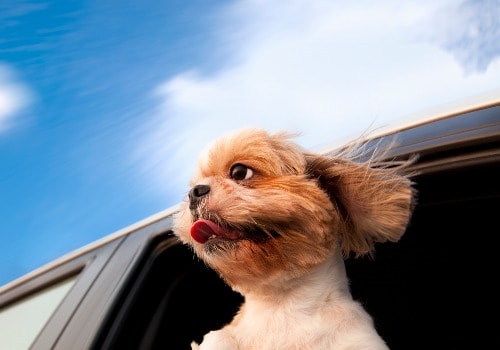Common knowledge goes that dogs love riding in cars, but the truth is, there are plenty who would rather die than go for a road trip. Why do dogs hate car rides, and is there any way to change their minds?
As with many canine quirks, it helps to take a step back and look at the scenario from your dog’s point of view. So let’s put on our doggy goggles and find out what it is about car rides that provokes such a negative reaction.
Five Reasons Why Dogs Hate Car Rides

1. Your Dog May Have Had Negative Experiences in Cars
Did you adopt your dog from an animal shelter or rescue? Does he have a history of abuse, neglect or other trauma in his life?
If so, there’s a good chance that his dislike of car rides is related to his negative past.
Maybe he associates riding in the car with being driven to the shelter or getting abandoned in the middle of nowhere. Perhaps his previous owners frequently left him in a hot car or locked him in one as a punishment for bad behavior.
But even if your dog has had a kind, loving family his entire life, he may still associate car rides with bad things. If his only experience with cars has been going to the vet for shots or the groomer for nail trims, who could blame him for thinking that that’s all cars are for?
How to Help Your Dog Overcome Negative Car Experiences
The trick here is going to be getting your dog to make some positive memories in cars.
Incorporate regular fun, short trips into your routine. Take him to the dog park, the pet supply store or a friend’s house once a week or so.
On these trips, have another person come along and sit next to your dog, petting him and talking to him calmly and sweetly. It may take some time, but he’ll grow to enjoy car rides more and more.
2. Car Rides May Give Your Dog Motion Sickness
Have you ever gotten queasy while riding around in a car? If so, you’re familiar with motion sickness — and you may not be the only one.
Dogs can get carsick just like humans do. Signs of motion sickness include wobbliness, dizziness, whining, drooling and vomiting.
Your dog may try to lie down, cover his face or curl up in a ball to alleviate the symptoms.
How to Cure Your Dog’s Carsickness
Avoid taking your dog on car rides right after he’s eaten to avoid upsetting his stomach. And make sure he stays hydrated to prevent headaches, which can make carsickness worse.
You can also talk to your vet about using over-the-counter motion sickness medication on your dog. The vet can advise you on proper dosage and give specific brand suggestions.
3. Cars Can Make Dogs Feel Claustrophobic

Some dogs love the combination of a safe, small enclosed car and exciting sights and smells whizzing by out the window.
But for others, that same combination can cause anxiety and feelings of claustrophobia.
This is especially likely if your dog doesn’t like being confined in other ways, such as being crated or hugged tightly. Some dogs just don’t like small spaces — if they don’t have a way out of a room or enclosure, they start to panic.
How to Prevent Your Dog’s Claustrophobia on Car Rides
If your dog hates small spaces, he may never grow to fully enjoy car rides. But you can often make progress by acclimating him to small spaces at home.
Work on crate training your dog to get him used to being in close quarters. Once he’s OK with going in his crate, you can try putting the crate in your car and crating him during car rides.
You may also want to talk to your vet about anti-anxiety medication to calm your dog’s nerves during car rides.
4. Your Dog May Get Bored in the Car
Every dog has his own interests, and for some, watching the world from a moving car just isn’t one of them.
It’s easy to understand his boredom if you’ve ever been stuck in a traffic jam or reluctantly tagged along on a road trip. There’s only so much you can do to occupy yourself when you’re sitting in a car before you become frustrated, irritable and grouchy.
So if your dog is highly active or just isn’t into idle entertainment, car rides may be as dull for him as watching paint dry. Who would want to put themselves in such a situation?
How to Keep Your Dog Occupied in the Car
Buy a few toys and keep them in your car. Don’t let your dog play with them at home — if he’s only allowed to play with them in the car, he may be more interested in hopping in.
And on longer drives, make frequent pit stops to let your dog expend some energy and stretch his legs. It’ll be good for you, too!
5. The Car Itself May Be Uncomfortable for Your Dog
It’s entirely possible that your dog doesn’t mind car rides — he just hates your car.
If you’ve got your vents blasting ice-cold AC air or engine-block heat right at your dog’s face, he could be extremely uncomfortable. And if you have the windows down, the combination of high-speed wind and loud outside noises could overwhelm his senses.
Your seats may be comfortable for you, but your dog likely has different standards. If the seats aren’t wide enough for your large dog to lay or sit on comfortably, he probably won’t be chomping at the bit to go for a car ride.
How to Make Your Car More Comfortable for Your Dog
Keep your climate control under control: don’t point vents directly at your dog, but aim them off to the sides instead. If you have any issues with your car’s exhaust or other noisy, smelly components, get them fixed to avoid hurting your dog’s sensitive ears and nose.
Your dog may also be more comfortable if you fold your seats down to create a larger area for him to rest on. And laying down his favorite blanket or bringing his dog bed along can work wonders, too.
